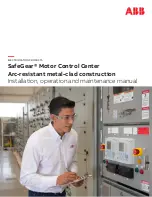
9
SA FEG E A R® MOTOR CONTROL CE NTE R/A RC- R E S I STA NT M ETA L- CL A D CON STRUC TI ON
Secondary and control connections
The MCC was wired in the factory in accordance with the Project specific Connection Diagrams. Refer to
project specific drawings for locations of the incoming and outgoing wiring terminal blocks.
Openings in the side of the MCC in the Low Voltage/Instrument compartment area allow control connections
between sections. When shipped in groups of several units each, the factory installs interconnection wiring
between groups. The factory then disconnects and tags one end of each of the connections, then pulls the
wire bundle back across the split within the adjacent frame. Reconnect these interconnections according to
the project specific connection diagrams after the equipment shipping sections are installed in place. See
Appendix C.
Primary cable connections
Area for connection of primary cables is provided in the cable compartment either through the roof or floor
as indicated in the General Arrangement drawings. The gland plates are made of .074” stainless steel - these
plates must be utilized in the final assembly. Holes for entrance of power cables or conduits must be cut in
the gland plate(s) and a sealing type bushing used.
Connection to control source
The control source wiring should be properly sized to support the requirements of the control circuit. Connect
the control source leads to the terminal blocks as indicated on the project Connection Diagrams.
Note: Check the electrical phasing before connecting.
All secondary power and control wiring should be routed through the provided locations and utilize the rubber
grommets cut with the appropriate size center hole to accommodate the wiring bundle. Failure to do so will affect
the arc-resistant integrity of the MCC.
WARNING
Use of sealing bushings for all power cable entries is required. Failure to do so will affect the arc-resistant integrity
of the MCC.
WARNING













































